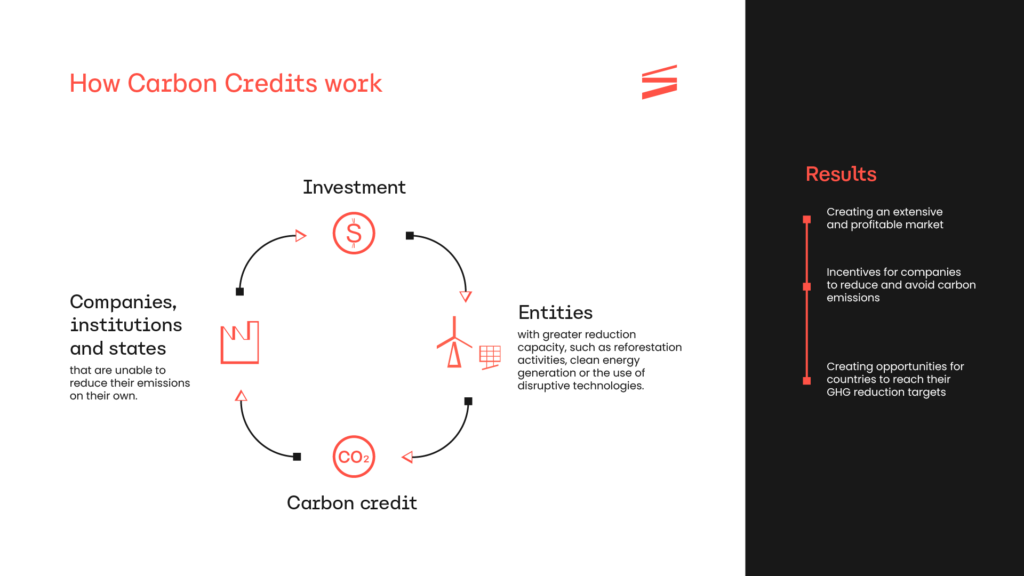Mais buscados:
Energy
Residential
Business
Renew Energy
Do you know what the relationship is between carbon credits and Greenhouse Gases (GHG)? It is very likely that you’ve heard about GHG emissions and how they impact climate change. Carbon credits emerged as a means to offset these emissions and halt global warming.
To better understand carbon credits, their origin and the carbon market, continue reading this article!
In 1997, the Kyoto Protocol was signed, an international agreement that required participating countries to reduce their GHG emissions through commitments and targets. This agreement led governments to take action to reduce the amount of polluting gases emitted into the atmosphere.
Despite considerable adherence, having been ratified by 96 countries, including Brazil, the Protocol presented a weakness: countries that emitted the most polluting gases into the atmosphere, such as the United States, did not accept the protocol’s terms. Furthermore, developing countries like China and India were not required to meet targets.
All things considered, the Kyoto Protocol was a milestone in the climate agenda for several reasons, one being the creation of the Clean Development Mechanism (CDM) – a tool that allows countries to achieve emissions reduction targets through carbon credits or Renewable Energy Certificates.
This was the first step for these mechanisms to gain space on the climate agenda. This is when the carbon market began to develop, but gained strength with the signing of the Paris Agreement.
In 2015, the Kyoto Protocol was replaced by the Paris Agreement. Experts defended the idea that the Protocol, signed in Japan, no longer had the necessary effectiveness to combat the advance of global warming. Therefore, during the United Nations Conference of the Parties (COP) 21, the countries signed a new treaty.
Seeking cooperation with the goal of stopping the increase in the Earth’s temperature, the Paris Agreement set relevant goals for all participating countries.
The importance of carbon credits.
By consensus among all parties, the goal to limit the increase in global temperature to below 2ºC was established. By signing the agreement, all countries, including Brazil, committed to establish targets to reduce their greenhouse gas (GHG) emissions, outlining action plans to achieve them.
In this scenario, through its Nationally Determined Contribution (NDC), Brazil committed to reduce its emissions by up to 37% by 2025, and 43% by 2030. To achieve this target, it is necessary to increase the use of alternative energy sources and invest more in clean and sustainable energy.
Other goals that Brazil committed to achieve by 2030 include:
A carbon credit is a unit of measurement used to calculate the reduction (or the amount avoided or captured) of Greenhouse Gases globally. A carbon credit is equivalent to one ton of CO2 that is no longer emitted or is captured before entering the atmosphere.
Carbon credits are like certificates, which can be traded between countries, institutions and individuals that want to neutralize CO2 emissions.

Created by the Kyoto Protocol and Paris Agreement, carbon credits have already fostered the development of an extensive, complex market of great potential.
Furthermore, they have also become a way to encourage companies to reduce and avoid carbon emissions. In addition, carbon credits are also major facilitators for achieving goals related to reducing Greenhouse Gases.
The main advantages of carbon credits include:
Investing in the purchase of carbon credits is a way of keeping your company aligned with the global purpose of climate change and thus generate value for the products and/or services you offer.
Carbon credit and global warming
Governments, institutions and individuals that are not able to reduce their GHG emissions buy carbon credits from institutions that have the ability to reduce or capture their GHG emissions – be it through reforestation activities or energy generation via clean sources or the use of technologies for said reduction.
Qualified companies, such as Serena, which end up not emitting tons of GHG into the atmosphere by generating energy from 100% clean sources, can certify their assets to issue carbon credits and sell them.
Tons of GHG are emitted every day. In 2021 alone, 2.42 billion gross tons of carbonic acid gas were emitted in Brazil, which is 12.2% more than 2020. To turn around this scenario, it is important that global warming not only be a government concern, but also of companies, non-governmental organizations and society.
An important next step for the carbon credit market in Brazil is the development of specific and broad domestic regulations that meet the needs and particularities of the country and of each sector, establishing real (yet ambitious), sectoral and progressive targets for reducing and offsetting GHG emissions.
Your company can be part of this sustainable transformation. Find out how your business can be a lead player in a low-carbon economy.
Also read:

Receive the latest news from Serena and the energy market!
